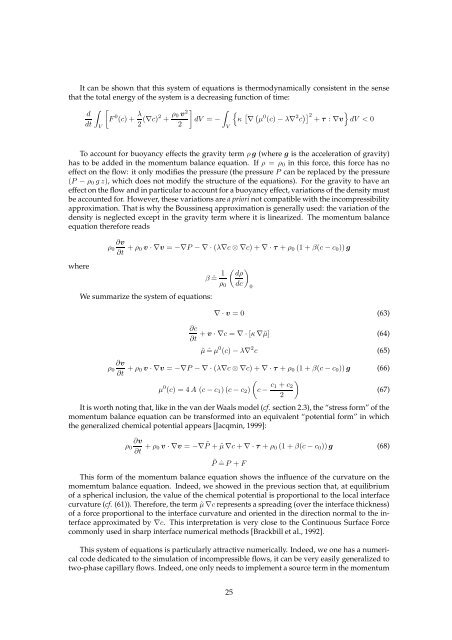Diffuse interface models in fluid mechanics
Diffuse interface models in fluid mechanics
Diffuse interface models in fluid mechanics
You also want an ePaper? Increase the reach of your titles
YUMPU automatically turns print PDFs into web optimized ePapers that Google loves.
It can be shown that this system of equations is thermodynamically consistent <strong>in</strong> the sensethat the total energy of the system is a decreas<strong>in</strong>g function of time:∫ddt V[F 0 (c) + λ 2 (∇c)2 + ρ 0 v 22] ∫dV = −{κ [ ∇ ( µ 0 (c) − λ∇ 2 c )] }2+ τ : ∇v dV < 0VTo account for buoyancy effects the gravity term ρ g (where g is the acceleration of gravity)has to be added <strong>in</strong> the momentum balance equation. If ρ = ρ 0 <strong>in</strong> this force, this force has noeffect on the flow: it only modifies the pressure (the pressure P can be replaced by the pressure(P − ρ 0 g z), which does not modify the structure of the equations). For the gravity to have aneffect on the flow and <strong>in</strong> particular to account for a buoyancy effect, variations of the density mustbe accounted for. However, these variations are a priori not compatible with the <strong>in</strong>compressibilityapproximation. That is why the Bouss<strong>in</strong>esq approximation is generally used: the variation of thedensity is neglected except <strong>in</strong> the gravity term where it is l<strong>in</strong>earized. The momentum balanceequation therefore readswhereρ 0∂v∂t + ρ 0 v · ∇v = −∇P − ∇ · (λ∇c ⊗ ∇c) + ∇ · τ + ρ 0 (1 + β(c − c 0 )) gWe summarize the system of equations:β ˆ= 1 ( ) dρρ 0 dc0∇ · v = 0 (63)∂c+ v · ∇c = ∇ · [κ ∇˜µ] (64)∂t˜µ ˆ= µ 0 (c) − λ∇ 2 c (65)∂vρ 0∂t + ρ 0 v · ∇v = −∇P − ∇ · (λ∇c ⊗ ∇c) + ∇ · τ + ρ 0 (1 + β(c − c 0 )) g (66)(µ 0 (c) = 4 A (c − c 1 ) (c − c 2 ) c − c )1 + c 2(67)2It is worth not<strong>in</strong>g that, like <strong>in</strong> the van der Waals model (cf. section 2.3), the “stress form” of themomentum balance equation can be transformed <strong>in</strong>to an equivalent “potential form” <strong>in</strong> whichthe generalized chemical potential appears [Jacqm<strong>in</strong>, 1999]:ρ 0∂v∂t + ρ 0 v · ∇v = −∇ ˜P + ˜µ ∇c + ∇ · τ + ρ 0 (1 + β(c − c 0 )) g (68)˜P ˆ= P + FThis form of the momentum balance equation shows the <strong>in</strong>fluence of the curvature on themomemtum balance equation. Indeed, we showed <strong>in</strong> the previous section that, at equilibriumof a spherical <strong>in</strong>clusion, the value of the chemical potential is proportional to the local <strong><strong>in</strong>terface</strong>curvature (cf. (61)). Therefore, the term ˜µ ∇c represents a spread<strong>in</strong>g (over the <strong><strong>in</strong>terface</strong> thickness)of a force proportional to the <strong><strong>in</strong>terface</strong> curvature and oriented <strong>in</strong> the direction normal to the <strong><strong>in</strong>terface</strong>approximated by ∇c. This <strong>in</strong>terpretation is very close to the Cont<strong>in</strong>uous Surface Forcecommonly used <strong>in</strong> sharp <strong><strong>in</strong>terface</strong> numerical methods [Brackbill et al., 1992].This system of equations is particularly attractive numerically. Indeed, we one has a numericalcode dedicated to the simulation of <strong>in</strong>compressible flows, it can be very easily generalized totwo-phase capillary flows. Indeed, one only needs to implement a source term <strong>in</strong> the momentum25











![[Diffusion-Limited Aggregation - A Model for Pattern Formation].](https://img.yumpu.com/52395246/1/190x245/diffusion-limited-aggregation-a-model-for-pattern-formation.jpg?quality=85)




